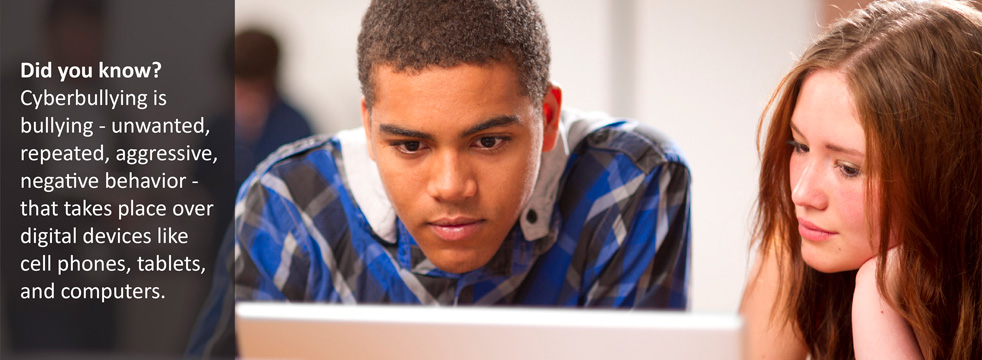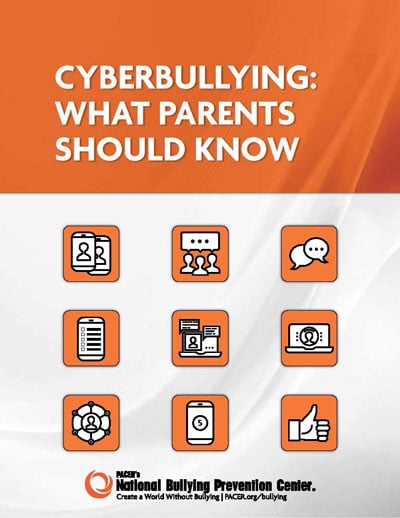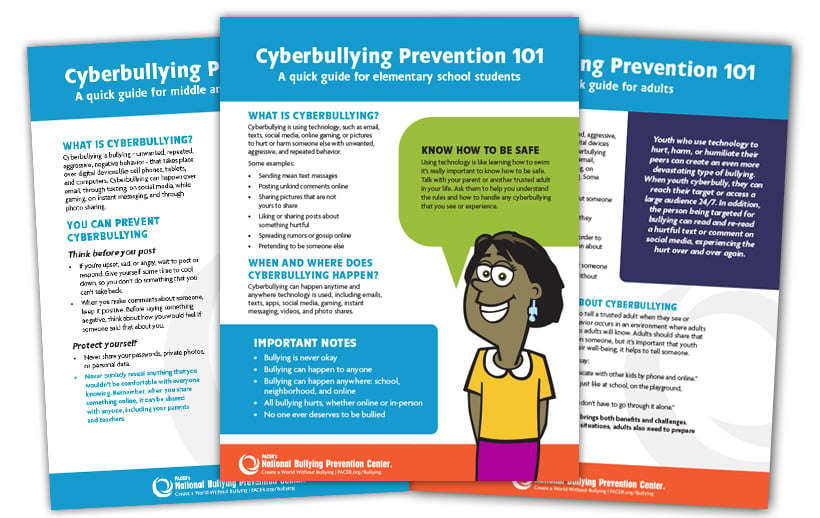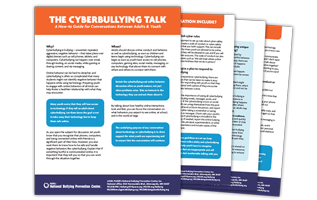What Parents Should Know About Bullying
Mobile and Online Safety

Using Technology to Bully
With the rapid advancement of technology, bullying behavior has become a part of many children’s experience online. Cyberbullying is when the Internet, cell phones, or other devices are used to send or post text or images intended to hurt or embarrass another person. It encompasses a range of activities from sending emails or text messages to someone who has requested no further contact with the sender, but may also include threats, sexual harassment, inappropriate photos, and ridiculing someone publically in online forums. Some children who cyberbully may post lies, rumors or gossip about the target and encourage others to share and distribute that information.
Many parents are particularly concerned about cyberbullying because while adults often have an understanding of the bullying that happens face to face, using technology to hurt someone else may be a new phenomenon for them. While cyberbullying is still less common than traditional bullying, it can be particularly damaging because it:
- can happen even after the child leaves school for the day,
- can be anonymous,
- is frequently very public with a potentially unlimited audience, and
- is often easier to be cruel when you don’t have face to face interaction.
At the same time, many parents are not active on the same websites or technology as their children and may not have knowledge of what their child is experiencing while online or on their phone.

Cyberbullying: What Parents Should Know
Students now live at a time of instant access to cell phones, tablets, or computers, which open the door to exciting new ways of connecting, interacting, and learning. However, these new modes of communication also present new challenges for parents. Not only do parents have to help children and youth navigate in-person social situations, they also need to prepare them for healthy relationships online. This 16-page booklet has information for parents on how to guide their children through this virtual world. Download the booklet.
Definition
While the definitions of cyberbullying, sometimes called online bullying, vary from source to source, most definitions include the following:
- Willful: The behavior has to be deliberate, not accidental.
- Repeated: Bullying reflects a pattern of behavior, not just one isolated incident.
- Harm: The target must perceive that harm was inflicted.
- Computers, cell phones, and other electronic devices: This, of course, is what differentiates cyberbullying from traditional bullying.
(Cyberbullying Research Center)
The technology, accessed through computers or cell phones, used to cyberbully includes:
- personal websites
- blogs
- texting
- social networking sites
- chat rooms
- message boards
- instant messaging
- photographs
- video games
For more information on the definition of cyberbullying, visit “Cyberbullying”
Other helpful definitions include:
- Cyberbullying is defined as “willful and repeated harm inflicted through the use of computers, cell phones, and other electronic devices” (Hinduja & Patchin, 2015 ).
- Cyberbullying occurs “when someone repeatedly makes fun of another person online or repeatedly picks on another person through e-mail or text message or when someone posts something online about another person that they don’t like” (Cyberbullying Research Center, 2016 ).
- Cyberbullying is intentional and repeated harm inflicted on others through the use of electronic devices (Cyberbullying Research Center, 2016 ).

Cyberbullying Prevention 101 Quick Guides
The three-version series with audience relevant content for elementary school students, middle and high school students and adults outlines how cyberbullying is defined, along with information on how to prevent and address the behavior.

Cyberbullying Prevention Infographics
A three-version infographic series with audience relevant content for elementary school students, middle and high school students and adults. The format is designed to share on social media, print for the classroom, and use as an friendly to read resource.
The Cyberbullying Talk: A How-to Guide for Conversations Between Adults & Youth

This four-page handout for adults features information about the why and when of talking with youth along with helpful tips that the conversation should include. Download Guide
How Parents Can Help Kids Cope in the Age of Cyberbullying
In HEMAWARE, a digital magazine, author Rita Colorito interviews staff from PACER's National Bullying Prevention Center, sharing important information for parents. “It’s important for kids to know that they have a right to be safe on their cellphone just like they have a right to be safe in school. It should be a good experience,” Hertzog says.
Plan to Protect Your Child From Cyberbullying
Today’s children are the first generation to experience cyberbullying, and today’s parents are the first that must determine how to respond to it. Remember, giving children access to technology is much like sending them to a mall or school dance. Children have rules, curfews, and guidelines when they venture into the outside world – they also need them in the cyber world. Set the rules, establish the parameters, and learn the technology. In fact, let your children show you how the technology works.
As you venture into this territory, consider these steps:
- Raise the topic of cyberbullying with your child
Now that you know bullying online is a real possibility, initiate the conversation. Bullying can be hard for children to talk about with their parents for many reasons. They might be embarrassed by what is happening, afraid that if they tell that it will get worse, or think it is their problem. Online bullying can add additional complications. Many students can recognize bullying when it happens in person, but students might not interpret the mean and hurtful behavior that happens on their computer or cell phone as bullying. Children often think that if they tell their parents they are being cyberbullied, their parent’s first reaction will be to “protect them” by removing their access to technology.
Open the subject for discussion, and tell your child:
- “I understand how important it is to communicate with your friends by phone and online.”
- “You deserve to be safe from bullying online, just like at school.”
- “If something happening online is hurtful to you, it is bullying, and it’s important to tell me about it.”
- Set cyber safety rules
You set safety rules for your child in the physical world. Do the same in your child’s cyberworld. Remind your children that they never know who is on the other end of cyber communication. It could be the person they think it is, but because they cannot see that person, they should always proceed with caution in their exchanges.
With that in mind, here are two good guidelines: “Don’t do or say anything online that you wouldn’t do or say in person," and, "Don’t reveal anything online that you wouldn’t tell a stranger.” Specific advice for your child might include:
- Never give out your e-mail password, a photo, or any personal data, such as a physical description, phone number, or address. A person bullying could use that information to harass you in many ways.
- Never share too many personal details. For example, if you keep an online diary, someone could use that information to bully or ridicule you.
- Never share your Instant Messaging (IM) account password with anyone, even your best friend. That friend may share it with others – or the friendship may end – and your private messages could suddenly become public. A cyberbully with your password can sign on, pretend to be you, and behave inappropriately with others to embarrass and humiliate you.
- Keep social media accounts private and do not “friend” people you do not know.
- Never respond with “revenge bullying,” as this can lead to a cycle of not only being bullied, but also become someone who bullies.
- Know what your children are doing online
Privacy is important, but safety is more important. As a parent, you have a responsibility to know what your child is doing online. Establish rules about your access to your child’s cell phones, text history, social networking sites, and other accounts they may use for posting information. Make decisions about passwords, how often you will check the accounts, and how inappropriate information will be handled.
Keep your child’s computer in an open area, such as the family room, where you can supervise your child’s Internet activity. Decide if there will be limits on access to using technology to communicate with peers, such as no computer or texting after 9 p.m., during meals, or until homework is done.
If you do discover that your child is experiencing cyberbullying, document it by printing the e-mails or web pages, saving electronic copies, and contacting your child’s school or the police.
Technology offers your children many advantages and benefits – and occasionally some risks. The solution is not to remove their access to technology, but to manage these risks. You can do that by being aware of your child’s cyber activities, learning about new technologies, and setting rules for your child’s online use.
How do I start a conversation about cyberbullying with my child?
Talk with your kids about how to handle hurtful online behavior early and often, in the same way that you talk with your kids about being safe at school, in the car, riding public transportation, or playing sports. Visit the Questions Answered page which provides a 60-second response, a feature article, video, and online poll.
Starting the Conversation About Online Safety | PACERTalks About Bullying, Episode 14
Tips about how parents can start the conversation about online safety with their child or student.
Cyberbullying: What Youth Need to Know
During October’s National Bullying Prevention Month, Ryley from Youth MOVE Nevada (a youth inspired and youth led podcast that explores mental health and youth serving systems) interviewed Danna Mirviss from PACER's National Bullying Prevention Center to discuss what cyberbullying is, why it is so harmful, and what youth can do if they are experiencing cyberbullying or see it happening.
A Conversation With Your 13-Year-Old About Facebook and Instagram
Sponsored by Facebook, Instagram, and PACER’s National Bullying Prevention Center
Connecting Responsibly
Just a generation ago, teens were asking their parents for a phone in their room – maybe even one with a separate line or three-way calling – so they could connect with more friends. Today, a teen’s desire to connect with friends has not changed, but the options for doing so have grown tremendously. Children are not only asking for their own mobile phones at a younger age, but they also want access to popular social media sites, like Facebook, and apps such as Instagram. While these platforms offer teens the opportunity to share ideas, photos, videos, and more, they come with the need for social responsibility too.
Setting up a new account
When you and your 13-year-old decide it is time to set up a Facebook or Instagram account, you should consider the following:
- Begin with a conversation
Talk with your kids about safety and technology early and often, in the same way that you talk with your kids about being safe at school, in the car, riding public transportation, or playing sports. - Ask how Facebook and Instagram work
Share your teen’s interest for connecting with others, and ask them to show you how Instagram, Facebook, and other social media platforms work. Teens are usually the experts. You can learn a lot from listening to them and, it shows that you value their interests and knowledge! - Establish some guidelines
Discuss with your teen what is and isn’t appropriate information to share online. Ask them about privacy settings, and suggest that you regularly review the information together. Create a code of conduct, such as:- We will not use social media to humiliate or embarrass other people.
- We will treat others online with the same respect that we do in person.
- We will not post videos or photos of others without their permission.
- Decide how you will interact online
Consider if you will interact with your child’s account. If you have a Facebook account, and have friended your child, respect the same boundaries you use offline. Let your relationship dictate how you interact – whether you join a conversation among your teen’s friends or if you post on their wall, for example. Think of social media as a get-together where kids gather at a friend’s house, and how you might interact with them in that setting.
Safety Tips
While the majority of teenagers may never experience inappropriate behavior online, it is important to have a conversation about online safety with your child. When the doors of communication are open, if your teen becomes uncomfortable with someone’s online behavior, they will be more likely to:
- Know how to recognize that the behavior is inappropriate.
- Recognize their rights.
- Trust that you won’t respond by removing access to their accounts.
- Tell you about it.
- Know that there are ways to prevent it from happening again.
- Have more confidence in how to handle the situation.
Take action
If your teen tells you that they are being hurt, humiliated, or harassed on Facebook or Instagram, there are several steps they can take to make it stop. Share these tips with your child:
- Ignore it – If the incident is something that doesn’t really matter to you and won’t affect your reputation, take a deep breath and let it go, and use some of the tools described below, like blocking and unfriending. Most bullies are looking for a reaction, so show them you’re confident by not responding.
- Unfollow or untag yourself from the offending post or photo – If someone has posted something you don’t like, you may unfollow the post (on Facebook) or untag yourself from the post or photo (on Facebook and Instagram).
- Unfriend the person – On Facebook, you can remove a connection to a friend that you are no longer comfortable sharing with by unfriending them.
- Report the content to Facebook or Instagram – You can report any content that violates Facebook‘s Community Standards or Instagram’s Community Guidelines. Remember to give a clear description of where the content is. You may also want to take screenshots of any offending posts, photos, or conversations with the person who is bullying you.
- Block the person – If you are being harassed by someone, or if you don’t want to be visible to them on Facebook, you can block the person from your timeline. When you block someone, they can no longer add you as a friend, send you messages or see your timeline, and you can no longer see theirs. On Instagram, you can also block another person, which means that they will no longer be able to see any of your photos or videos. Keep in mind that blocking someone also means you will no longer be able to report their content.
- Social Reporting – Facebook offers the social reporting tool, which allows you to communicate directly with a person about content they have posted that you don’t like. In cases of bullying or harassment, where you don’t feel comfortable reaching out to the person directly, you can use social reporting to get help from a trusted friend.
Record Keeping and Reporting
An important part of addressing a cyberbullying situation is keeping a record of what has happened. It’s tempting for children who are being cyberbullied to delete messages and other bullying content sent to them, especially if they are trying to ignore the bullying. But this can become problematic if you need to provide proof of the cyberbullying to school officials or law enforcement officials later on. Remember that if it isn’t in writing, it doesn’t exist.
How to capture evidence of cyberbullying:
- Take screenshots of bullying content on a phone or computer.
- Save emails, messages, texts, photos, etc.
- If bullying is also happening in person, make sure to record the date and description of each event that your child tells you about.
- Many social media sites have safety pages that provide guidelines for how to address cyberbullying on their site:
Check Your Knowledge
-
Why can cyberbullying sometimes be more damaging than traditional bullying?
- It can happen at any time of day
- It can by anonymous.
- It can by highly public.
- All of the above.
Check Answer
All of the above. While cyberbullying is still less common than traditional bullying, it can be particularly damaging because it can happen even after the child leaves school for the day, it can be anonymous, and it is frequently very public with a potentially unlimited audience. At the same time, many parents are not active on the same websites or technology as their children and may not have knowledge of what their child is experiencing while online or on their phone.
-
True or False: Any information your child puts online or on their phone can be easily shared, copied, and pasted in other places.
Check Answer
True. Talk to your kids about their “digital footprint” and the fact that what goes online stays online. Make sure your kids know that any information they share online—photos, videos, emails, text messages and more—can be easily shared, copied and pasted in other places.
-
True or False: Many social media sites offer some sort of system to report bullying content.
Check Answer
True. Many social media sites such as Facebook and Instagram have systems to report bullying content. You can report any content that violates Facebook‘s Community Standards or Instagram’s Community Guidelines. Remember to give a clear description of where the content is. You may also want to take screenshots of any offending posts, photos, or conversations with the person who is bullying you. Facebook also offers the social reporting tool, which allows individuals to communicate directly with a person about the content they have posted that you don’t like.
-
True or False: If your child is being bullied online, you should immediately delete all of the bullying messages and posts.
Check Answer
False. It’s tempting for children who are being cyberbullied to delete messages and other bullying content sent to them, especially if they are trying to ignore the bullying. But this can become problematic if you need to provide proof of the cyberbullying to school officials or law enforcement officials later on. Remember that if it isn’t in writing, it doesn’t exist. If your child is being cyberbullied online, it’s important to take screenshots of bullying content on a phone or computer. Save emails, messages, texts or photos.



